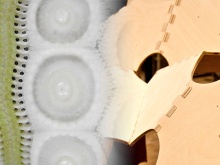The studio focuses on the design and construction of a research pavilion situated on the plaza between the university buildings K1 and K2. The project utilizes a specific construction principle which was developed in the context of the previous "Performative Morphology" studio. It references biological precedents, in particular rigid plate structures found in echinoideas such as sea urchins or sand dollars. More specifically, the intricate finger joints connecting the plates translate structural forces into shear forces such that no bending moments occur across the entire plate system. The geometric complexity of the joints leading to complexity in fabrication will, in conjunction with robotically aided manufacturing, enable the design of a differentiated and sustainable structure.
In a first stage of the project, a team consisting of students and faculty members will develop a digital building information model integrating design geometry with fabrication constraints and material parameters. In a feedback loop, results from structural analysis and physical load testing will inform the digital model. In a parallel effort students will become familiar with the use of the robotic fabrication technologies and augment the information model with their knowledge. A main focus will be the parametric integration of the digital model and the robotic fabrication process of the physical building components. Ultimately, a prototype will be built in scale 1:1 similar to last year.
The aim of the project is to provide the students with the opportunity to apply computer-aided design and fabrication methodologies in an integrated manner to a real-world project. The completion of the project including design development, documentation, fabrication and assembly of the design within the course of one semester will require stamina and true commitment.


